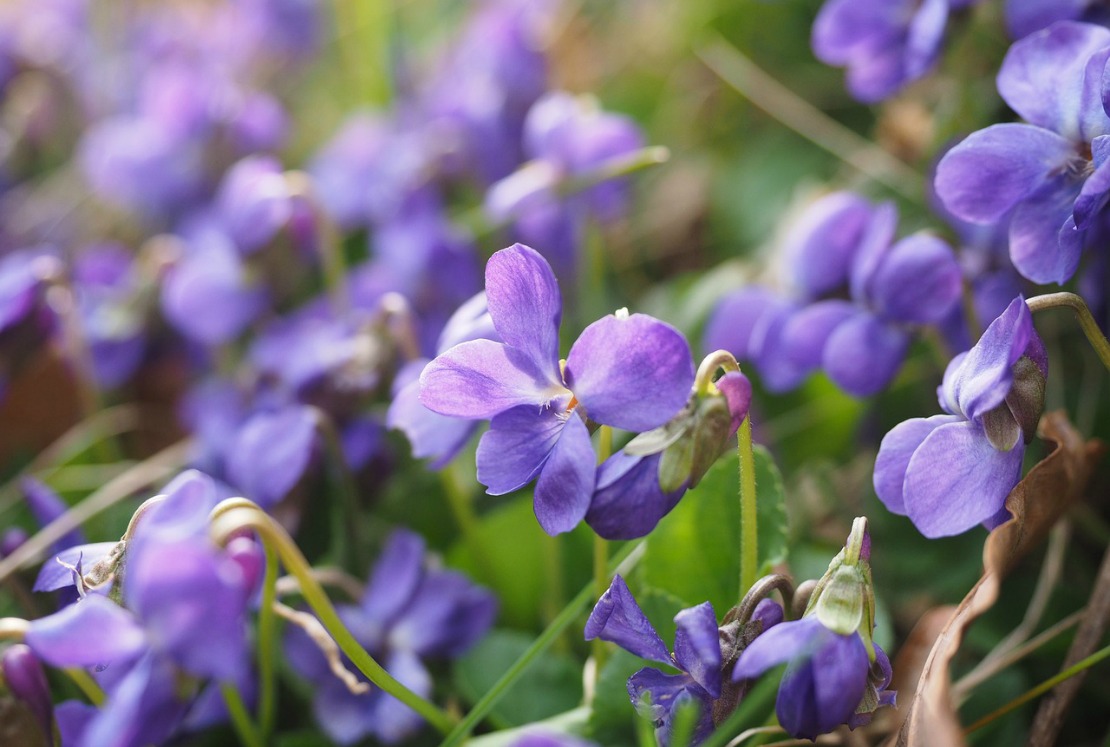Sweet Violet Benefits: A Materia Medica
/This monograph was originally published in Natural Herbal Living Magazine, April 2015
Common Name: Violet, Sweet Violet, Shy Violet, Viola, Wild Pansy, Heartsase, Pansy, Johnny-Jump-Up
Latin Name: Viola odorata, V. tricolor plus many, many other species
Family: Violacaea
PROPERTIES & ACTIONS: cooling, moistening, demulcent, nutritive, expectorant, lymphagogue, alterative, dissolvent, anodyne, vulnerary, antiseptic, emollient, laxative, anti-inflammatory, anti-rheumatic, anti-neoplastic, diuretic Root ~ emetic, cathartic, expectorant, antipyretic
CONSTITUENTS: mucilage, saponins, salicylates, vitamin A, vitamin C, antioxidants, phytosterols, quercetin, essential oils
PARTS USED: Mainly leaves and flowers.
DESCRIPTION: Viola odorata grows in moist, shady areas although they will spread into lawns and gardens as well. Often found in grouped in masses the plants grow close to the ground. While budding, the little flowers hide beneath the heart shaped green leaves. The asymmetrical flowers have 5 petals: two petals on top, two on the side and one at the base of the flower with a tiny yellow center. Blossom color ranges from singular colored deep purple to yellow to white or even combinations of the three. Once in full bloom the flowers appear above the leaves. The flowers have a distinctive heavenly odor. Violet leaves are a bit downy. They roll in at the edges when young and as the age become flatter.
SPRINGTIME VIOLET
Violet’s delightful scent wafts through the air early each Spring announcing the arrival of the beginning of growth and renewal. The tiny vivid purple flowers of this herb are all full of beautiful fragrance and has beneficial uses. This lovely little plant only flowers for a short while each Spring, truly a gift from the Earth.
The beloved violet has been revered throughout the ages. The flower’s sweet beauty symbolizing modesty, fertility and love while finding use as for soothing the heart, respiratory system and more. This tiny unassuming plant is full of gentle yet powerful.
NOURISHING VIOLET
Violet is full of delicious nutrients! Traditionally used as a nutritive food, violet is a superbly nourishing vitamin rich food that eases and soothes with it’s gentle slippery mucilage. Specifically violet leaves and flowers are high in vitamin C and vitamin. A “A cup of violet infusion supplies 6,000 IU carotenes.”1 While the “100 grams of fresh spring leaves contain 264 mg of ascorbic acid and 20,000 IU of vitamin A.”2
Use violet leaves to make delicious salads and soups. The flowers are beautiful as a special garnish on salads, cakes and cookies. They can be preserved through crystallization and used as a cheerful decoration during the long winter.
A CHILD’S FRIEND
Violet is a wonderful children’s herb. The enchanting little flowers and softly fuzzed heart shaped leaves are so fun to play with, certainly the fairies love violas! The flowers and leaves make a lovely little snack when playing out of doors on a happy Spring day. Use the flowers to make a gift for the fairies or to decorate salads and cookies. A favorite project for kids is making violet honey!
All this fun and violet also lends a hand when children aren’t feeling well. It gently soothes away childhood coughs while cooling inflammation, fevers and easing associated aches and pains. Specifically the flowers help ease coughs and soothe scratchy throats. In fact, violet flower syrup is renowned as a wonderful cough remedy for children. The syrup also helps to ease children’s stomach aches acting as a gentle laxative in cases of constipation. Heartsease are specific for cradle cap in babies as well as childhood eczema and other scaly skin conditions.
COOLING SOOTHER
A compassionate friend, violet supports the heart helping people through times of grief and heartache. The sweet little flowers are said to “gladden the heart” providing comfort and strength.
Violet eases the pain of headaches and tension by gently dissipating heat while supporting the body and the nerves. It will help to clear heat from the head related to to nervousness, fever and infections. Violet brings about cooling sleep especially easing a restless mind and a sad heart. Violet also finds use in easing the pain and inflammation of arthritis and rheumatism.
Violet nourishes the body while reducing the heat of inflammation as well as moistening and lubricating the tissues providing profound yet gentle relief from dryness. Expertly stated by herbalist Kiva Rose, “Something I adore about Violets is their gentle, but thorough nature. For cooling, calming, lymph moving, pain relieving kind of action this flower is a master.”3 These wonderful qualities find use in many conditions.
Violet is wonderful for gently yet powerfully clearing congested lymphatic states. It helps both at the beginning of illness when the nodes are tender and warm, used internally and externally, and will also helps in clearing chronically stuck lymphatic issues.5
Violet is a cooling, moistening expectorant that soothes respiratory ailments such as bronchitis, whooping cough, and flu in particular those associated with irritable coughing and thick, yellow catarrh. The slippery soothingness of violet will also help relieve sore throats. Jim McDonald offers a clever idea of “keeping a wad” of fresh leaf in your cheek to take advantage of the mucilage in the leaf for a sore throat.4
Slippery, soothing mucilage relieves stomach aches and constipation. The mucilage along with violet’s antiseptic action also helps in cases of urinary discomfort such as cystitis and infections.
SISTERLY LOVE FOR WOMEN
For women, violet offers up sisterly love decreasing swellings and soreness in breast tissue, for instance, in mastitis, fibrocystic breasts, PMS, lumps and cancer. For nursing mothers, a soothing violet poultice is amazing for soothing cracked nipples and relieving the heat and pain of mastitis. Violet oil is a beautiful choice for a breast oil. It is wonderful for massaging into the breasts during loving self-care as well as for bring welcome relief to swollen fibrocystic breasts and even as a helper when dealing with cancerous lumps.
HERBAL CANCER ALLY
Violet has a long history of use in dissolving lumps in the body - violet has has been used by herbalists to by those dealing with cancer of the breasts, lungs, lymphatic glands, urinary tract and GI tract. Violet leaf oil and poultices applied to the breast are said to help “dissolve lumps, cysts, calcifications and growths.” Weed states that she “considers them [the poultice] especially invaluable when dealing with in situ carcinomas.”6 Weed further explains that both “internal and external use of violet can shrink a breast lump in a month.”7 She also explains that violet has the ability to slow cancer growth.8 The leaves are said to relieve “the pain in cancerous growths, especially in the throat.”9
Violet is also a wonderful addition to any longevity lifestyle. In her book “Breast Cancer? Breast Health!” Weed encourages us to use violet as part of an anticancer lifestyle. She explains that high amounts of phytochemicals present in plants like violet assists the body in staying healthy and nourishing the immune system.
EXTERNAL USES
As an external remedy violet leaf is wonderful for cooling hot inflamed skin issues. A poultice, oil or wash is used to soothe fresh abrasions as well as more persistent purulent wounds. Violet also helps clear pimples and abscesses by disinfecting and dissolving. Use topically as an oil or poultice for dissolving lumps It can be used both internally and externally for helping ease more chronic issues such as eczema and herpes. A gentle wash made with violet with help sore eyes.
GETTING TO THE ROOT
Violet’s roots are strong indeed and should be used by skilled herbalists only as they can cause stomach distress as well as issues with breathing and blood pressure. Similarly to the leaves and flowers, the roots are used to cool and clear issues with respiratory illness.
PREPARATION & DOSAGE
Infusion: Prepare the leaves and flowers as an infusion left to infuse for at least 4 hours to overnight and drink freely.
Tincture: Viola tricolor ~ 30 to 40 drops 2 to 5 times per day for adults, use Clark’s Rule to adjust for children.10
Syrup: 1-5 tsp per day of violet flower syrup, take just before bed for insomnia.11
Topical Preparations: Prepare as a wash, poultice or oil and apply as needed increasing frequency with acuteness of the situation.
SAFETY CONSIDERATIONS
In large doses the roots can cause extreme stomach upset and issues with breathing and blood pressure “regulation.” The leaves may cause an allergic reaction such as itchiness, burning and “minor eruptions”12
I Love Learning About Herbs, Do You?
Here is some more violet information from various herbalists and bloggers for your herbie enjoyment!
Three Faces Under the Hood: The Many Aspects of Violet by Kiva Rose
A Family Herb: Violet Plant by me over at the Herbal Academy
Recipes and fun for kids!
More Please!
1 Susun S. Weed, Breast Cancer? Breast Health! pg.46
2 Susun S. Weed, Healing Wise, pg. 243
3 Kiva Rose, Shy Violets: For Grace, Fluidity and Sweetness
4 Jim McDonald, Violet Herb
5 Jim McDonald, Violet Herb
6 Susun S. Weed, Breast Cancer? Breast Health! pg. 11
7 Susun S. Weed, Breast Cancer? Breast Health! pg. 289
8 Susun S. Weed, Breast Cancer? Breast Health! pg. 289
9 Mrs M. Grieves, A Modern Herbal, pg. 839
10 Ed Smith, Therapeutic Herb Manual, pg. 53
11 Susun S. Weed, Healing Wise, pg. 246
12 Susun S. Weed, Healing Wise, pg. 240
References
Books:
Couplan, Francois Ph.D., The Encyclopedia of Edible Plants of North American, Keats Publishing, 1998
Grieve, Mrs. M., A Modern Herbal, Random House, 1973
Hoffman, David, The Complete Illustrated Herbal, Element Books, 1996
McIntyre, Anne, Flower Power, Henry Holt & Company, Inc., 1996
Smith, Ed, Therapeutic Herb Manual, Ed Smith, 1999
Tilgner, Sharol, N.D., Herbal Medicine from the Heart of the Earth, Wise Acres Press, Inc., 1999
Weed, Susun S., Breast Cancer? Breast Health!, Ash Tree Publishing, 1996
Weed, Susun S., Healing Wise, Ash Tree Publishing, 1989
Websites:
Shy Violets: For Grace, Fluidity and Sweetness: http://bearmedicineherbals.com/shy-violets-for-grace-fluidity-and-sweetness.html
Violet Herb - A Guest Post by Jim McDonald: http://www.methowvalleyherbs.com/2014/03/violet-herb-guest-post-by-jim-mcdonald.html
Emerging From Winter To Find Violet: http://www.methowvalleyherbs.com/2010/02/emerging-from-winter-to-find-violet.html






















